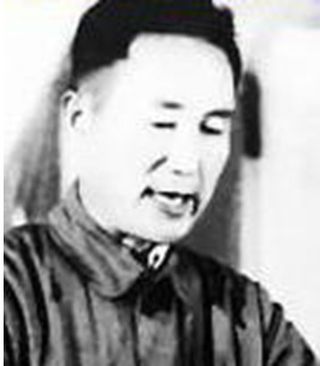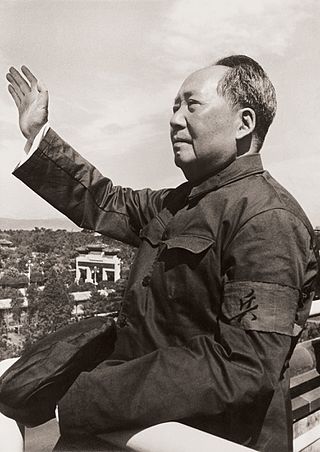Related Research Articles
Generation name is one of the characters in a traditional Chinese, Vietnamese and Korean given name, and is so called because each member of a generation share that character.

Chen Boda, was a Chinese Communist journalist, professor and political theorist who rose to power as the chief interpreter of Maoism in the first 20 years of the People's Republic of China. Chen became a close associate of Mao Zedong in Yan'an, during the late 1930s, drafting speeches and theoretical essays and directing propaganda.
The "Five Black Categories" were classifications of political identity defined during the period of the Chinese Cultural Revolution (1966–1976) in the People's Republic of China by Mao Zedong, who ordained that people in these groups should be considered enemies of the Revolution.

Jian Bozan was a Chinese scholar and Marxist historian of Uyghur descent. Born in Taoyuan County, Hunan Province, Jian became an early supporter of the Chinese Communist Party. From 1952 to his death, he was Vice President of Peking University. Like many authoritative academic figures of his generation, he was persecuted during the Cultural Revolution over a perceived divergence between his own ideas and that of dominant Maoist orthodoxy of the time. Unable to bear torture, Jian committed suicide in 1968.

Struggle sessions, or denunciation rallies or struggle meetings, were violent public spectacles in Maoist China where people accused of being "class enemies" were publicly humiliated, accused, beaten and tortured, sometimes to death, often by people with whom they were close. These public rallies were most popular in the mass campaigns immediately before and after the establishment of the People's Republic of China, and peaked during the Cultural Revolution (1966–1976), when they were used to instill a crusading spirit among crowds to promote Maoist thought reform.
Qi Benyu was a Chinese Communist theorist, mainly active during the Cultural Revolution. Qi was a member of the ultra-left Cultural Revolution Group, director of the Department of Petitions and deputy director of the Secretary Bureau of the Central Committee of the Chinese Communist Party. Qi also acted as head of the history department of the communist theory journal Red Flag. In 1968 he was arrested, stripped of all his positions, and sent to prison.

The Shadian incident was an uprising of Muslim Hui people against the rule of Chinese Communist Party (CCP) during the Cultural Revolution, which was eventually suppressed by the People's Liberation Army in a massacre. In July and August, 1975, the uprising and the subsequent military suppression took place in several villages of Yunnan Province in southwest China, especially at the Shadian Town of Gejiu City. The estimated death toll was around 1,600 including 300 children, and 4,400 houses were destroyed.

Pan Fusheng was a Chinese Communist revolutionary and politician. He was the first party secretary of the short-lived Pingyuan Province of the People's Republic of China, and also served as the First Secretary of Henan and Heilongjiang provinces.

Liu Geping was a Chinese communist revolutionary and politician of Hui Muslim heritage. He is best known as the founding Chairman of the Ningxia Hui Autonomous Region and later for seizing power in Shanxi during the Cultural Revolution, where he made himself the top leader of the province.
Counterattack the Right-Deviationist Reversal-of-Verdicts Trend (反击右倾翻案风), later known as Criticize Deng, Counterattack the Right-Deviationist Reversal-of-Verdicts Trend (批邓、反击右倾翻案风), was a Chinese political campaign launched by The Gang Of Four in November 1975 against Deng Xiaoping's anti-Cultural Revolution program. It was one of the last movements during the Cultural Revolution, and continued briefly under Hua Guofeng after Mao's 1976 death, before it officially ended with Deng's rehabilitation in July 1977.

Cow demons and snake spirits, also rendered in English as ox-demons and snake-spirits is a Chinese term used during the Cultural Revolution (1966-1976) to demonize perceived enemies. Tang dynasty poet Du Mu (803–852) coined the term in the preface of a poetry collection by Li He (791–817) to praise the fantastical elements in Li's poetry.

Yan Fengying, born Yan Hongliu, also known as Yan Daifeng, was a Chinese Huangmei opera artist who played dan (female) roles. Though she lived a short life, she left such a mark and is today remembered as the "queen of Huangmei opera".

Red August is a term used to indicate a period of political violence and massacres in Beijing beginning in August 1966, during the Cultural Revolution. According to official statistics published in 1980 after the end of the Cultural Revolution, Red Guards in Beijing killed a total of 1,772 people during Red August, while 33,695 homes were ransacked and 85,196 families were forcibly displaced. However, according to official statistics published in November 1985, the number of deaths in Beijing during Red August was 10,275.

The Daxing Massacre, also known as the Daxing Incident (大兴事件), was part of the Red August massacre in Beijing during the early Cultural Revolution. It took place in Daxing District of Beijing from August 27 to 31, primarily targeting members of the Five Black Categories. In total, 325 people were killed in the massacre by September 1, 1966; the oldest killed was 80 years old, while the youngest was only 38 days old; 22 families were wiped out.

The Violent Struggle, also known as Wudou or Factional Conflicts, refers to the violent conflicts between different factions during the Chinese Cultural Revolution (1966–1976). The factional conflicts started in Shanghai and Chongqing in December 1966, and then spread to other areas of China in 1967 which brought the country to the state of civil war. Most violent struggles took place after the power seizure of rebel groups, and gradually grew out of control in 1968, forcing the Central Committee of the Chinese Communist Party as well as the Chinese government to take multiple interventions in the summer of 1968.

The Guangdong Cultural Revolution Massacre was a series of massacres that took place in Guangdong Province of China during the Cultural Revolution. There were 80 counties in Guangdong during the Cultural Revolution, and according to the 57 county annals which became available during the "Boluan Fanzheng" period, massacres occurred in 28 of the counties with six counties recording a death toll of over 1,000—the average death toll among all the 28 counties was 278. The massacre in Yangjiang was the most serious, with over 2,600 deaths in Yangchun County alone. In addition, massacres also occurred in some cities of Guangdong; in the capital city Guangzhou, for example, the massacre targeting the prisoners of Laogai resulted in the deaths of at least 187–197 people within a week of August 1967.

Song Yongyi is a Chinese American historian who specializes in the study of Chinese Cultural Revolution. He currently works at the California State University, Los Angeles, and previously served as a college librarian at the Dickinson College in Pennsylvania.
The Six Articles of Public Security, more formally known as the Regulations on Strengthening Public Security Work in the Great Proletarian Cultural Revolution, was a directive promulgated on January 13, 1967, by the Central Committee of the Chinese Communist Party and the State Council of the People's Republic of China. Its six points directed state and Party organisations to take steps to punish counterrevolutionaries, strengthen the dictatorship of the proletariat and defined categories of "bad members of society". It was one of the main formal justifications for the mass persecution of millions of people in the Cultural Revolution. In 1979, the Central Committee cancelled it after the directive had been blamed for the large numbers of unjust punishments and false accusations that accompanied the Cultural Revolution.
Chen Shaomin was a Chinese Communist Party politician.
The bloodline theory or blood lineage theory was a political theory associated with the "Loyalist Faction" of the Red Guards during the early phase of the Cultural Revolution in the People's Republic of China. Opponents included the "Rebel Faction" of the Red Guards.
References
- ↑ Yiching Wu (16 June 2014). The Cultural Revolution at the Margins. Harvard University Press. pp. 332–. ISBN 978-0-674-72879-0.
- ↑ Guo Jian; Yongyi Song; Yuan Zhou (23 July 2015). Historical Dictionary of the Chinese Cultural Revolution. Rowman & Littlefield Publishers. pp. 404–. ISBN 978-1-4422-5172-4.
- ↑ Philip F. Williams; Yenna Wu (17 August 2004). The Great Wall of Confinement: The Chinese Prison Camp through Contemporary Fiction and Reportage. University of California Press. pp. 162–. ISBN 978-0-520-93855-7.
- ↑ Sujian Guo; Baogang Guo (2008). China in Search of a Harmonious Society. Lexington Books. ISBN 978-0-7391-2623-3.
- ↑ Andrew G. Walder (5 March 2012). Fractured Rebellion: The Beijing Red Guard Movement. Harvard University Press. pp. 338–. ISBN 978-0-674-26818-0.
- ↑ Guo Jian; Yongyi Song; Yuan Zhou (17 September 2009). The A to Z of the Chinese Cultural Revolution. Scarecrow Press. pp. 206–. ISBN 978-0-8108-7033-8.
- ↑ Guo And Guo (15 August 2008). China in Search of a Harmonious Society. Lexington Books. pp. 167–. ISBN 978-0-7391-3042-1.
- ↑ Daniel Leese; Puck Engman (25 June 2018). Victims, Perpetrators, and the Role of Law in Maoist China: A Case-Study Approach. Walter de Gruyter. pp. 46–. ISBN 978-3-11-053365-1.
- ↑ "Looking Back at the Cultural Revolution (21): Theories of Blood Lineage and Family Background". Voice of America . 2007-04-06. Archived from the original on 2010-11-25.
- ↑ "Qi Benyu and the Central Cultural Revolution Group". Radio Free Asia . 2016-07-06.
- ↑ Henry He (22 July 2016). Dictionary of the Political Thought of the People's Republic of China. Routledge. pp. 595–. ISBN 978-1-315-50043-0.
- ↑ "A new book release of the brother of Yu Luoke". Radio Free Asia . 2010-03-11.
- ↑ S. Jiang (16 June 2015). Citizen Publications in China Before the Internet. Palgrave Macmillan. pp. 216–. ISBN 978-1-137-49208-1.
- ↑ Liu Qingfeng (1996). The Cultural Revolution: Evidence and Analysis. The Chinese University of Hong Kong Press. pp. 273–. ISBN 978-962-201-763-4.